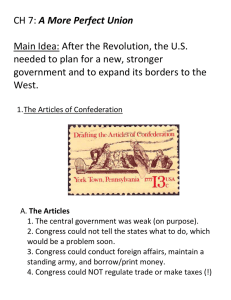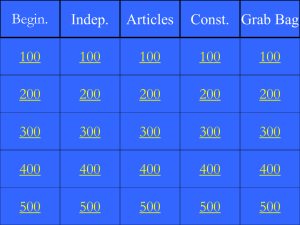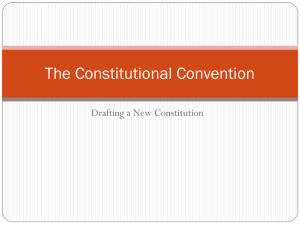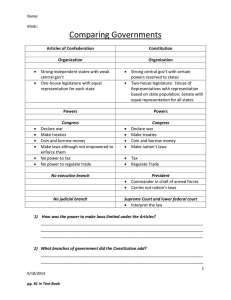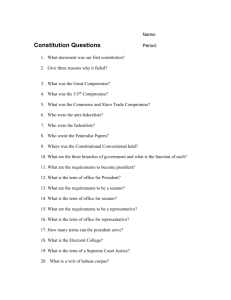2016 U.S. History Miderm study guide
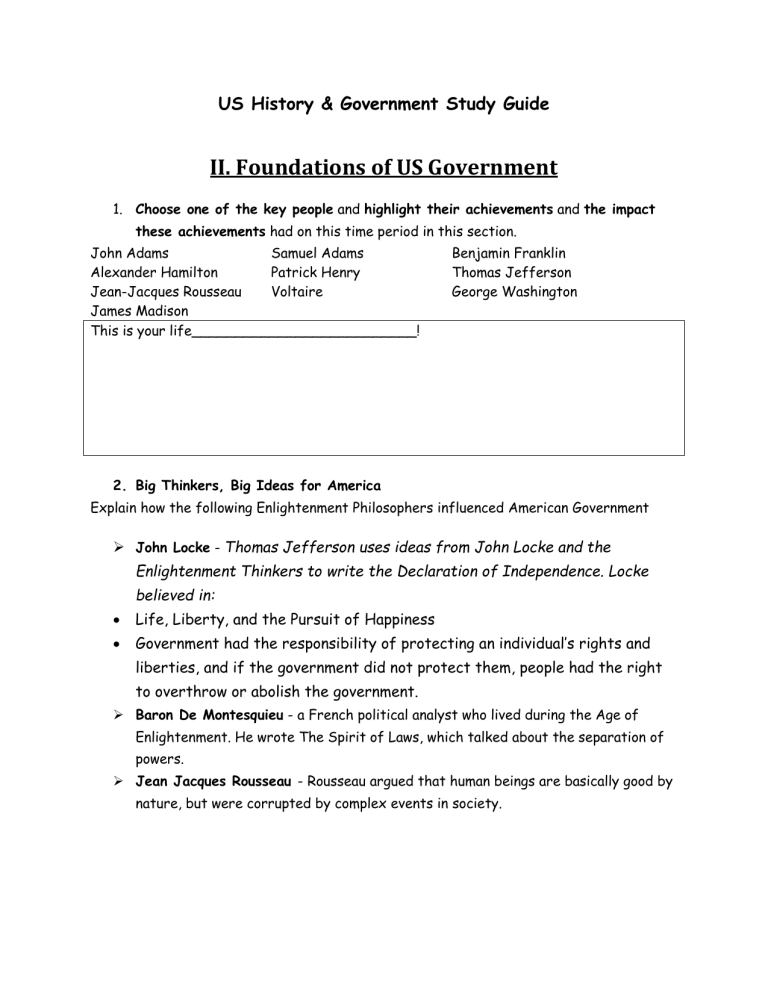
US History & Government Study Guide
II. Foundations of US Government
1.
Choose one of the key people and highlight their achievements and the impact
these achievements had on this time period in this section.
John Adams
Alexander Hamilton
Samuel Adams
Patrick Henry
Jean-Jacques Rousseau Voltaire
James Madison
This is your life__________________________!
2.
Big Thinkers, Big Ideas for America
Benjamin Franklin
Thomas Jefferson
George Washington
Explain how the following Enlightenment Philosophers influenced American Government
John Locke - Thomas Jefferson uses ideas from John Locke and the
Enlightenment Thinkers to write the Declaration of Independence. Locke believed in:
Life, Liberty, and the Pursuit of Happiness
Government had the responsibility of protecting an individual’s rights and liberties, and if the government did not protect them, people had the right to overthrow or abolish the government.
Baron De Montesquieu - a French political analyst who lived during the Age of
Enlightenment. He wrote The Spirit of Laws, which talked about the separation of powers.
Jean Jacques Rousseau - Rousseau argued that human beings are basically good by nature, but were corrupted by complex events in society.
3.
Early Attempts at Self-Government
Virginia House of
Burgesses
Ideals of Democracy
Mayflower Compact This was an agreement for the settlers on how to govern their colony. This was one of the first steps in American for self-
government (democracy).
A law making assembly made up of representatives from the colony.
This is the first instance of limited self-government in the English colonies.
Fundamental Orders of Connecticut
The framework for the government of the Connecticut colony from
1639-1662.
4.
What was the Proclamation Line of 1763?
The proclamation forbade all settlers from settling past a line drawn along the Appalachian
Mountains. It closed off the frontier to colonial expansion. The King and his council presented the proclamation as a measure to calm the fears of the Indians, who felt that the colonists would drive them from their lands as they expanded westward.
How did the Proclamation Line help to push the colonies toward war with Britain?
The colonists resented this and ignored the King’s rule, which pushed them toward war with
Britain.
5.
Causes of the Revolution – Explain how the following led to the American
Revolution
CAUSES
Reversal of Salutary Neglect—An economic system of mercantilism still exists BUT the mother country (England) begins to relax economic control over the colonies equal to economic freedom = more $$$ POWER. When Britain tried to impose more rules and take control over the colonies again, the colonies were upset.
Mercantilism—
-
Colonies exist to benefit the mother country
-
Raw materials are sold by the colony to the mother country (i.e. timber)
-
In return, mother country sells finished products back to the colony (i.e. desk
-
There are trade restrictions on the colonies selling to other countries.
Stamp Act and Intolerable Acts—This law placed a tax on newspapers, pamphlets, legal documents, and most other printed materials. This was supposed to pay the cost of keeping British troops in America. The Stamp Act and Intolerable Acts angered the colonists and caused them to renew boycotts and to call to the people of all the English colonies to arm themselves and form militias.
“No Taxation without Representation”— because the colonies didn’t have representation
in the British Parliament, they felt the British had not right to force laws on the colonies.
Therefore they used this argument to protest the Sugar Act.
6.
Discuss three ideas the government expressed in the Declaration of Independence. a.
The people have self-evident truths: All men are created equal and they have certain unalienable rights. b.
The three unalienable rights are: Life, Liberty and the Pursuit of Happiness c.
The government derives its “just powers” from the =consent of the governed.
7.
Explain the main ideas of each piece of literature by Thomas Paine and how each one influenced the American Revolution.
Thomas Paine (1776) wrote Common Sense a 47-page pamphlet which discussed the Revolution. It convinced many readers to support a complete break with Great Britain. The Crisis were pamphlets that were written in a language that the common man could understand, and
represented Paine's philosophy.
Articles of Confederation
1781-1789
Strengths
Successful conclusion of the
American Revolution
Negotiated the Treaty of Paris
Passage of the Land Ordinance of
1785 and the Northwest Ordinance of 1787 which set a pattern of how new states could join the
nation. It also did not allow slavery in the Northwest Territory
Weaknesses
strong state governments and a weak central (national, federal)
government
One vote for each state, regardless of size
No single national currency
Congress could not collect taxes
No separated executive branch to enforce acts of Congress
Congress powerless to regulate foreign and interstate commerce
No national court system to interpret laws
Amendment only with consent of all the states
A 9/13 majority required to pass laws
III. Writing & Ratifying the Constitution, 1787-1789
Explain what the constitutional issue was for each compromise and how compromise was reached.
Compromise
Great
Compromise
Issue
New Jersey Plan: equal representation— favors smaller populated states.
Create a new stronger central government and a weak state government
Virginia Plan: representation based on population—favors larger populated states.
What compromise was reached
A bicameral system was reached.
The New Jersey Plan was used for the Senate (2 members per state).
The Virginia Plan was used for the
House of Representation (number of representatives based on population).
3/5
Compromise
The south wanted to count slaves as people for representation and as property for tax purposes. The North said—No, you can’t have it both ways
They will count each slave as three fifths of a person, so 5 slaves = 3 people.
Trade
Compromise
*Southerners opposed tariffs because their economy was heavily dependent upon trade.
*Northerners wanted tariffs to protect their industries from foreign competition.
The Constitution allows the federal government to tax interstate trade but not intrastate trade.
Governments of the United States: 1781 and 1789
How the Weaknesses of the Articles of Confederation
Were Corrected by the Constitution
Articles of Confederation Constitution of the United States
States have most of the power. The national government has little
No executive officer to carry out the laws of Congress
No national courts. Only state courts exist
Congress is responsible to the states
Nine out of 13 states have to approve a law before it can go into effect
Congress has no power to tax
Congress cannot regulate trade among the states
Each state coins its own money. No national currency
States have some power, but most is given to the national government
A president heads the executive branch of the government
Both national and state courts exist.
Congress is responsible to the people
Laws may be passed by a majority vote of both houses of Congress
Congress given the power to tax
Congress given the power to regulate interstate and foreign trade
Only the national government has the power to coin money
Ratification
Reserved
Powers
Delegated
Powers
Concurrent
Powers
Federalism
Federalist
Papers
Approve
Definitions
Powers reserved for the states
Establish schools, Pass statewide laws, regulate intrastate trade
Powers delegated to the federal government
Regulate interstate trade, coin money, declare war, sign treaties
Powers held and exercised by both the national and state governments
Preamble
Separation of
Powers
A strong central government
Written by Alexander Hamilton, James Madison & John Jay, they were a series of essays to persuade the NY State convention to agree to the
Constitution
The preamble describes the purpose of the government set up by the
Constitution. We the people…
3 Branches of Government
1.
Legislative Branch—make laws
2.
Executive Branch—The President, enforces laws
3.
Judicial Branch—Supreme & Federal Courts
Explain what the debate was between the Federalists and the Anti-Federalists. Include who supported the Bill of Rights and why?
The Great Debate
Federalists
-James Madison
-They wanted a strong national government
Antifederalists
-Thomas Jefferson
-Wanted strong state government
-They were afraid the president would be like a king
-They feared for Americans’ individual liberties
The federalists added the Bill of Rights to appeal to the antifederalists. These were amendments designed to protect citizens’ rights.
IV. The
Constitution
Implied Powers
Powers not written in the Constitution—future power
This makes the constitution a “living document” and gives the government most of its power today
Flexible document based on the necessary and proper (or elastic) clause
Gives the Legislative Branch flexibility to make laws today. i.e. radio, internet.
Federalism
Delegated Powers:
Those powers specifically granted the
Federal Government by the Constitution.
Reserved Powers:
Those powers not delegated to the Federal Government or denied the states are reserved for the states.
Concurrent Powers: o
Regulate interstate and international trade
Powers that are shared by both the Federal and State o o
Regulate intrastate trade
Establish schools o
Coin money o
Declare war o
Maintain an armed forces
Governments.
Power to tax
Maintain courts
Borrow money o
Establish a postal system o
Enforce copyrights o
Sign treaties o
Establish local governments o
Pass statewide laws (ex.
Safety belt laws) o
Run elections
2. Give two specific ‘real life’ examples for each of the three powers.
Delegated Powers
1.
There is one common currency in the US
2.
Passports
Concurrent Powers
1.
There are federal prisons and state prisons
2.
Federal and state courts
Reserved Powers
1.
Drivers’ licenses
2.
Create schools
Explain the responsibility of the President under each ‘role’?
Chief of State This role requires a president to be an inspiring example for the American people.
Chief Executive The president is “boss” for millions of government workers in the Executive Branch, deciding how the laws are to be enforced.
Chief Diplomat The president represents the United States in negotiations with foreign countries, because the Constitution grants the President the power to negotiate and sign treaties on behalf of the United States
Commander in Chief The President is ultimately at the head of the chain of command for the Army, Navy, Air
Force, Marines and the Coast Guard.
Bill of Rights
1 st Amendment
Freedom of Speech, Religion, Press, Assembly, Petition
2 nd Amendment
Right to keep arms
3 rd Amendment
Right to protection from troops being quartered in homes during peacetime
4 th Amendment
Right against unreasonable search and seizure without a warrant
5 th Amendment
Rights of the Accused
10 th Amendment
Guarantee that the people and the states have all of the powers not specifically delegated to the federal government (reserved powers)
American History through Constitutional Law
Cases Quick Summary Outcome/Historical
Significance
Constitutional
Concepts/Enduring
Issues
Judicial v. Executive and
Marbury v.
Madison (1803)
McCulloch v.
Maryland (1819)
Appointment of midnight justices by John Adams rejected by
Jefferson. Supreme Court must decide constitutionality of
Judiciary Act.
Maryland attempts to tax the
National Bank of the U.S. Court must decide whether Bank is legitimate under the elastic clause and whether Maryland can tax it.
John Marshall declares
Judiciary Act unconstitutional
The Supreme Court has the right of Judicial Review. This means that it decides if a law is constitutional or unconstitutional
John Marshall declares “the power to tax is the power to destroy.” The Supremacy
Clause of the Constitution prohibits state taxation of a federal institution.
Federal law takes precedent over State
Law.
Congressional Power
Judicial Review
Separation of Powers
State Rights
Elastic Clause
Judicial Review
Federalism
Gibbons v. Odgen
(1824)
Dred Scott v.
Sanford (1857)
Ogden receives exclusive right from New York to use Steam boat to navigate in NY and to NJ.
Gibbons get right from Congress.
Dred Scott was a slave who was brought into free Territory as defined by the Missouri
Compromise.
John Marshall declares that
Congress has the exclusive authority to regulate Interstate
Commerce. Federal law takes precedent over State law.
The supreme Court declared that slaves were property; therefore, he could be brought into the free area as a slave.
It also declared the Missouri
Compromise unconstitutional.
Judicial Review
Federalism
Article III citizenship rights vs. Fifth Amendment property rights.
Civil War causes
Federalism
Equality
1.
Explain the political importance of the Census every 10 years.
A census is given every 10 years to find out the population for representation in the
House of Representatives and for electoral votes.
2.
How is the number of electoral votes for each state determined?
The number of electoral votes for each state is determined by the number of
House of Representatives and Senators = the electoral
Two Issues: How to select the President, and how long is he/she president.
Two types of elections: Direct Election and Indirect Election
Direct election:
1.
People vote for a candidate
2.
Person with the most votes wins
Indirect election:
1.
People vote for a representative
2.
Representative votes for candidate.
Election Compromise:
1.
Indirect election for the President and Senate
2.
Direct election for the House of Representatives
Electoral College:
1.
U.S. Senators 2 from each state times 50 states
2.
House of Representatives % according to population
A census is required every ten years to determine representation in Congress.
A criticism of the Electoral College is that presidents may be elected without
receiving the majority of the popular vote. You can win the population but lose the electoral vote. An example of this is Busch/Gore 2000
The Unwritten Constitution: Practices of the Government based on tradition &
customs. Examples: political parties, political conventions
President’s Cabinet
George Washington was the first President to have a cabinet. The purpose of the Cabinet is to advise the president.
Today, the president’s cabinet consists of the secretaries/heads of the 15 major departments of the executive branch (examples include: The Attorney General of the
Justice Department and The Secretary of State of the State Department. The newest is the Department of Homeland Security, which was created following the attack of
September 11, 2001).
Political Parties
The first political parties arose from the debates over who should have more power—the state or the national government.
Federalists Party – Alexander Hamilton Democratic-Republicans – Thomas
Jefferson
1.
Who should have more power?
National Government
1.
Who should have more power
State Government
2.
Loose Interpretation of the
Constitution
The Constitution is only a loose framework of laws on which the government could build the nation as it saw fit.
Judicial Review
2.
Strict Interpretation of the
Constitution
The government should not do anything that the Constitution did not specifically say it could do. (ex: such as start a national bank)
The most important power of the Supreme Court is the ability to declare laws
unconstitutional. The power of Judicial Review was a precedent set in the 1803 Marbury
vs. Madison decision. It also serves a check on the laws passed by Congress and the actions and treaties of the President.
V. Early Government in Action
George Washington
1.
Explain 2 Precedents set by George Washington
The president’s cabinet
Two terms in office
2.
The 22 nd Amendment (1947) made one of Washington’s precedents official by setting a Two-Term Limit for presidents.
3.
In his farewell address, George Washington advised the United States to follow a policy of Neutrality. America was able to follow this policy due to the geographic advantage of being in the western hemisphere.
4.
List 3 steps taken by Washington’s Secretary of the Treasury Alexander Hamilton that helped to establish the United States’ economy.
The national gov’t would take on the debts acquired by the states during the
Revolution.
He created a tariff to help raise money to pay off the debts.
The government paid an interest to creditors in return for the loan
5.
What did President Washington’s response to the Whiskey Rebellion show about the Federal government?
He showed that the Federal government was committed to enforcing its laws.
John Adams—2 nd President of the US
The XYZ Affair and the Alien and Sedition Acts
The young nation of America was tested early by the French in the XYZ Affair.
Americans were outraged by bribes demanded by French officials. The Alien and Sedition
Acts were laws signed by President Adams in 1798 as a result of the problems with france and England and to combat possible threats from both inside and outside the nation.
6.
Explain what the Alien and Sedition Acts stated.
The President gained the right to imprison or deport citizens of other countries residing in the U.S. Persons who wrote, published, or said anything “of a false, scandalous, and malicious” nature against the American government or its officials could be fined or jailed.
7.
What amendment did the Sedition act violate?
14 th Amendment
8.
How did the Virginia and Kentucky Resolutions attempt to limit the power of the
Federal Government?
They said that states had the right to judge whether federal laws agreed with the
Constitution. If a state decided that a law was unconstitutional, it could declare that law
“null and void” within the state.
9.
Who was John Marshall? What was his importance in shaping US government?
Chief Justice John Marshall ruled against Marbury, declaring it was against the Supreme
Court for the Supreme Court to order the executive branch.
**This was a victory for the Supreme Court for the case established the power of Judicial
Review
10.
Explain the historical significance of the following court cases:
Marbury vs. Madison
President Jefferson tried to deny the appointments of Federalist
judges that President Adams appointed right before he left office.
Chief Justice John Marshall ruled
against Marbury, declaring it was against the Supreme Court for the
Supreme Court to order the executive branch.
**This was a victory for the
Supreme Court for the case established the power of Judicial
Review
McCulloch vs. Maryland
John Marshall declares “the power to tax is the power to destroy.” The Supremacy
Clause of the Constitution prohibits state taxation of a federal institution. Federal law takes precedent over
State Law.
Gibbons vs. Ogden
John Marshall declares that
Congress has the exclusive authority to regulate Interstate
Commerce. Federal law takes precedent over State law.
The Louisiana Purchase
11.
The Louisiana Purchase was important to the growth of the United States because it:
Port of New Orleans- this was important for movement of crops down the
Mississippi
Doubled the size of the United States
Thomas Jefferson faced a dilemma when considering purchasing this land because he supported a strict interpretation of the Constitution and the Constitution did not state if the President had the power to purchase new territory.
The War of 1812
Causes and Effect of the War of 1812
Causes: Effects
The impressment of our seamen and the ships being taken to
British ports as the reason for the war
Encouraged Indians to attack
American settlers
It unified the country
Restored patriotism
The Monroe Doctrine (Also see handout)
US would defend Western Hemisphere from European interference
An end to European colonization in the Western Hemisphere
If Europe has a problem with the Western Hemisphere, see the US first
“Big Brother,” because European interference was “dangerous to our peace and safety.”
*This assumes a leadership role in the Western Hemisphere
We are also flexing our muscles
No interference by the US in European affairs and European colonies.
12.
Explain how the following Presidents invoked the Monroe Doctrine to support US policy.
William McKinley (1899) Teddy Roosevelt (1904) John Kennedy (1961)
Spanish American War Roosevelt Corollary Bay of Pigs/Cuban
The US to expand her reach across the globe, recognized that defeating a weak Spanish Empire offered an opportunity to gain territories outside north America. These territories would then provide access to world markets for growing manufacturing by US industries.
Theodore Roosevelt worked to increase US presence in Latin America via his Roosevelt Corollary to the Monroe Doctrine.
The Corollary stated that not only would Latin
America be considered a vital US interest and
European interference there considered a threat to the United States, but the US would and could actively intervene in Latin
America to protect those interests.
Missile Crisis
The US was not happy with Fidel Castro taking over Cuba, so Kennedy tried to have the US overthrow Castro, however, it was a disaster. The Soviet then tried to build missiles in Cuba. The US put a naval quarantine on
Cuba, so the Soviets backed down.
Ronald Reagan (1981)
Support of the
Contras in Nicaragua
Reagan sold weapons to
Iran in hopes of the release of hostages in
Iran. He used this money to support the
Nicaragua Contras who wanted to overthrow the government .
VI The Constitution Tested: The Nation Expands and
Divides
1.
Choose one of the Key People and highlight their achievements and the impact these achievements had on this time period in this section.
Key People:
Abraham Lincoln
Andrew Jackson
Ulysses S. Grant
Robert E. Lee
Frederick
Douglass
Harriet Tubman
This is your life _____________________________!
1.
Define: Sectionalism — Sectionalism is the devotion to a nation’s region rather than the nation. Differences between the North and South helped to create loyalty to their section of the country. They did not see themselves as Americans, but as Virginians, or southerners, etc. It made it easier to secede from the US.
2.
Explain how the South and the North differed in the early 1800’s
Economy
Slavery
Views on
Federalism
South
‘King Cotton’ and the cotton gin- many laborers were needed to pick cotton, and once the cotton gin was invented more laborers were needed.
Plantation System - Large farms in the South that used slave labor.
Slavery became more widespread in the South than in the North because of geographic factors.
Slaves were needed to pick the cotton on plantations. Most of these slaves were from Africa.
Believed that ultimate power should be in the hands of States’
Governments.
Nullification— a state’s refusal to recognize a federal law
North
Industry and factories in the cities in the north were important to their economy.
Immigrants were needed to fill these positions.
Abolition Movement — A movement in the north to free slaves
Believed in a strong central government.
President James Madison came up with a plan to bring the economies of the US together. Henry
Clay backed his plan and called it the American system.
Explain how the following helped to unite the economies of the North, South, and West.
Erie Canal – A waterway connecting Lake Erie to the Hudson River that aided the economic development of the U.S. by lowering the cost of shipping goods from the
Midwest to the Atlantic coast. The farmers in the Midwest could ship their goods to merchants in the east who would trade and sell the goods for a larger profit. It promoted growth of trade and manufacturing in the Northeast.
National Bank –
Andrew Jackson
The Presidency of Andrew Jackson
Fires over 2,000 government workers and replaces them with his own supporters
Vetoes more acts of Congress than all six previous Presidents combined
Closes Bank of the United States
Threatens to send huge army to South Carolina to force the state to obey tariff laws
Uses Indian Removal Act to force 100,000 Native Americans from their homelands
Jackson’s forceful actions earned him both strong support and angry opposition throughout the country
1.
What is the Spoils System?
Jackson used this to provide government jobs to his political supporters.
2.
Would you characterize Andrew Jackson as a Tyrant or a Man of the People?
Give
Examples
3.
Andrew Jackson was against the Native Americans when he signed the Indian Removal
Act , which stated that Jackson could give Native Americans land in parts of the
Louisiana Purchase in exchange for lands taken from them in the East.
4.
This started the Trail of Tears , which was in 1838 when the US Army rounded up more than 15,000 Cherokees in camps while settlers burned their homes and farms. Then they started a nightmare journey where men, women, and children, mostly on foot, began a
116-day forced march westward. One out of every four Cherokees died of cold or disease .
Manifest Destiny and the Slavery Issue
“…the fulfillment of our manifest destiny to overspread the continent allotted by
Providence for the free development of our yearly multiplying millions…”
~ newspaperman John L.
O’Sullivan
1.
Define:
Manifest Destiny: the idea that the U.S. should own the entire continent of U.S. from East to
West.
Cession: the giving up of rights.
Annexation: the forcible acquisition of a state's territory by another state
2.
Explain how the fulfillment of Manifest Destiny increased tensions over slavery.
As Southerners settled out West they wanted to bring their slaves with them and make the area slave territories. However, the abolitionists and Northerners did not want slavery in the West.
3.
Explain how each of the following attempted to solve the conflict over slavery.
Missouri
Compromise
Compromise of
1850
Maine – Admitted as a free state
Missouri –Admitted as a slave state
New territories north of the Missouri – Any territory north of the 36 30 line was a free state
California – Admitted as a free state
New territories of the SW “popular sovereignty” – the people would decide for themselves
Fugitive Slave Act –this ordered all citizens of the U.S. to assist in the return of enslaved people who had escaped from their owners.
The Kansas-
Nebraska Act
Popular Sovereignty – the people will decide on the issue of slavery in their territory.
4.
Explain how the following led to the Civil War
Bleeding Kansas
John Brown’s Raids
A group of Southerners with a proslavery federal marshal looted
Brown was a stern evangelical, who brought a group of people to
Dred Scott Decision
Dred Scott v. Sandford was a ruling newspaper offices and homes in
Kentucky, a center of antia proslavery settlement. He roused 5 men from their beds, on the question of slavery. It said that no African Americans, slave or free, were citizens, and therefore, slavery.
This stirred up a swift response dragged them from their homes and killed them. they were not entitled to protection from the Constitution. The ruling
from John Brown also held that the Missouri
Compromise was unconstitutional because Congress could not deprive the people their right to property.
(In other words, it overturned the
Missouri Compromise) Sectional conflict increased as a result of these decisions because it denied
Congress the power to regulate slavery in the territories.
5.
What was the immediate response by the Southern States to Abraham Lincoln winning the Election of 1860?
The immediate response by the South was to secede from the Union.
6.
Why did the Southern states respond this way?
They responded this way because Lincoln was a northerner and they believed he would outlaw slavery.
7.
Define: Secession – to withdraw from the Union
Abolition Movement
1.
Explain how the following abolitionists attempted to end slavery.
William Lloyd Garrison
“The Liberator”
Wrote an anti-slavery newspaper. He spoke out against slavery and for the rights of America's black inhabitants. He had a reputation for being one of the most radical abolitionists and advocated the immediate emancipation of all slaves
Frederick Douglass
“What to the American slave is your 4 th of July
A former slave who learned to read and write. He escaped slavery and spoke at abolitionist meetings. He went to Ireland & Britain to avoid capture and continued to speak there.
His followers there paid for his freedom. He was the most famous black man who used his status to influence the role of African
Americans in the country.
He also supported women’s suffrage.
Harriet Tubman
“The Underground
Railroad”
She was an African-
American abolitionist, humanitarian, and during the American Civil War, a Union spy. She is one of the most well-known conductors of the
Underground Railroad.
She helped slaves escape through a network of abolitionists.
Sojourner Truth
“Ain’t I a Woman?”
She was an African-
American abolitionist and women's rights activist, who was born into slavery, but escaped.
Sojourner is best known for her speech on racial inequalities, "Ain't I a
Woman?" delivered at the Ohio Women's Rights
Convention in 1851.
2.
Explain the importance of the book ‘Uncle Tom’s Cabin’.
Uncle Tom's Cabin is an anti-slavery novel by American author Harriet Beecher Stowe.
Published in 1852, the novel "helped lay the groundwork for the Civil War." It show the harsh realities that slaves had to endure.
3.
How did the abolition movement inspire the women’s suffrage movement?
Many male abolitionists did not like that women would take part in the public and believed they should use their influence only within their families. This caused women to fight for abolitionist rights as well as their own.
4.
Explain the purpose of The Seneca Falls Convention of 1848, which was led by Elizabeth
Cady Stanton and Lucretia Mott.
This was the first women’s rights convention in U.S. history. Stanton presented her Declaration
of Sentiments which echoed the language of the Declaration of Independence, at this meeting.
5.
The Major way that the Declaration of Sentiments differed from the Declaration of
Independence was that the word woman was added.
The Civil War (1861 – 1865)
“A House divided against itself cannot stand.”
1.
Lincoln’s main goal of the Civil War was to
unite the Union.
2.
Explain how Lincoln exercised his power as Commander-in-Chief by suspending Habeas
Corpus during the Civil War.
To silence opponents of the war, Lincoln suspended the writ of habeas corpus. This is a legal protection requiring that a court determine if a person is lawfully imprisoned. Without it, people can be held in jail for indefinite periods without even being charged for a crime. The
Constitution allows suspension of the writ during a rebellion.
3.
How did Lincoln use the Emancipation Proclamation as a strategic advantage during the
Civil War?
Originally, Lincoln did not feel he had the right to end slavery, but gradually, he came to regard ending slavery as one more strategy for winning the war.
It caused a “union” in the North
It kept Britain from supporting the South
It caused confusion in the South
4.
What advantages did the South have in the Civil War?
Homeland Advantage—The South was fighting a defensive war, and only had to do enough damage to the invading army that its troops lost morale. The South was defending its home against invaders; therefore, Southern whites felt a greater sense of unity than the Northern population.
Better Field Commanders—The best military minds belonged to Southerners.
Farmland—Soldiers had food
Total Troops
Wounded
1,566,678
275,175
Died of Wounds 110,070
Died of Disease 249,458
Casualties of the Civil War
Union Troops Confederate Troops
1,802,119
194,000
94,000
164,000
List the reasons for such high casualty rates.
Camps were unsanitary and water was polluted. Epidemics of contagious diseases, such as mumps and measles swept through camps. Prison camps in the South were overcrowded and prisoners died from starvation and exposure.
Some call the Civil War the first “modern war” because so many new technologies. Old standbys such as knives, swords, bayonets, older muskets and cannons played a role.
However, the first widespread use of the Gatling gun, faster-loading rifles with rifling in the barrels, and the new, deadlier ammunition called the min-ball were important advancements. This bullet revolutionized warfare because of its increased range and the havoc it wrecked on the human body.
Another relatively new technology played an important role in the war: the modern railway. The railroad made it easier and quicker to get supplies and food to the troops as well as transporting the troops to locations quickly.
Key People:
Andrew Johnson
Rutherford B. Hayes
Ulysses S. Grant
VII The Reconstructed Nation
This is your life_______________________!
The effort to rebuild the southern states and restore the Union was known as Reconstruction, a period that lasted from 1865 to 1877. It required the building of the economy as well as it’s government.
“With Malice Toward None, With Charity For All…”
~Abraham Lincoln
However…Lincoln’s plans for Reconstruction are cut short by the assassin’s bullet of John
Wilkes Booth on April 14, 1865.
1.
List the details for each plan for Reconstruction.
Presidential Plan (Lincoln and Johnson)
Amendments – 13 th Amendment – ended slavery
Amnesty - He wanted to pardon any
Confederate who would take an oath of allegiance to the Union and accept federal policy on slavery
10% Plan rejoin.
– If 10% of the people in a state swore their allegiance to the Union, they could
Treatment of freed slaves – did not give voting rights to black Americans
Congressional Plan led by Radical Republicans
Amendments – 14 th
Rights of Citizens, Right to Voted
Amnesty – They felt there should be a total restructuring of society to guarantee black people true equality.
& 15 th Amendments –
Military Districts – wanted to put the South under military rule, dividing it into five districts, each governed by a Northern general.
Freedman’s Bureau –
Congress created this to help black southerners adjust to freedom. It gave out clothing, medical supplies, meals, and a formal education in bureau schools.
The competing plans of Andrew Johnson and Congress eventually led to the impeachment of the president. Even the House of Representatives voted to impeach Johnson, the Senate and
Radical Republicans who supported Johnson’s conviction failed to convict him by only one vote!
Carpetbagger – Northern Republicans who moved to the postwar South
Scalawags – Southern whites who supported Reconstruction
Some Major changes were made to the Constitution too and Northerners found another way to get revenge on the South…
3.
Explain the purpose of each of the following Amendments.
13 th
Amendment 14 th
Amendment 15 th
Amendment
To ban all slavery or involuntary servitude.
All citizens of the U.S. can be deprived of life, liberty, or property without due process
The right to vote no matter your Race, color, Servitude
4.
“Actions speak louder than words” the government could pass all the amendments to the
Constitution that they wanted, but the whites in the South would find a way to take control.
↓
Black Codes rights
Laws that restricted
Freedman’s
↓ ↓
White Control of the South
Secret Societies Poll Taxes
Groups that excluded people. Ex: Ku
Klux Klan
Special fee that must be paid before a person can vote
↓
Literacy Tests
Voters had to demonstrate minimum standards of knowledge by
↓
Grandfather
Clauses
Exempts a group of people from obeying a law provided they passing tests specifically designed to keep
African Americans out met a certain condition before the law was passed.
Reconstruction officially ended when Rutherford B. Hayes ran against Samuel J. Tilden in the presidential election of 1876. Hayes received fewer popular and electoral votes than Tilden but became president after the Compromise of 1877. The Democrats agreed to let Hayes become
↓
Jim Crow
Laws
Laws that segregated public services by race beginning in the 1890s president in exchange for a complete withdrawal of federal troops from the South. Republicans agreed, and shortly after Hayes was sworn in as president, he ordered the remaining federal troops to withdraw.
5.
What power gave Hayes the right to remove federal troops from the South, effectively ending Reconstruction? Commander and Chief of the armed services .

